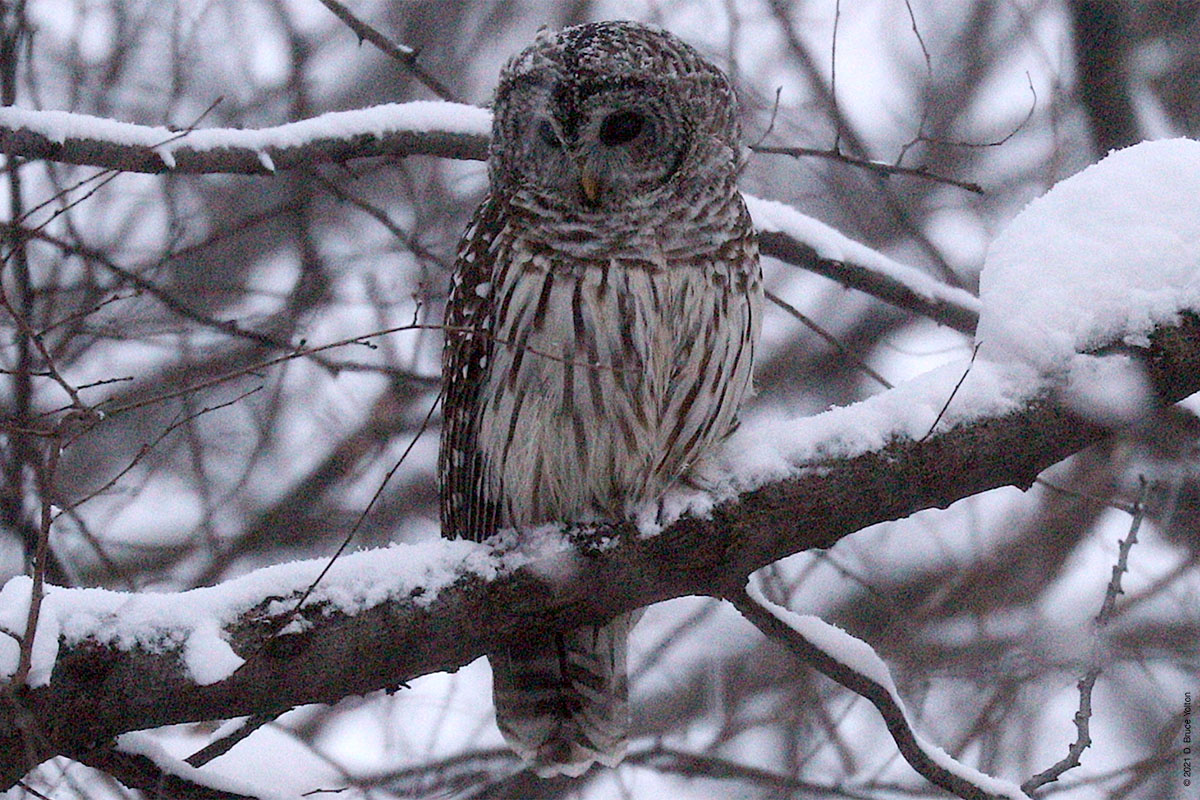The Barred Owl that died early Friday morning, due to an accidental collision with a park vehicle will be greatly missed by those who observed her. For ten months, she gave us many insights into her species’ behavior and we learned her individual habits. While we didn’t experience her raising young or finding a mate, we did get to see her hunt, bathe, manage territorial disputes with hawks, jays, robins and titmice and hear her wonderful calls. In the middle of a pandemic, she brought us so much joy. I’m going to miss her greatly.
When she arrived in the North Woods, in October of 2020 she was very active that the first week during the daytime. The first day I saw her, she had to deal with a Cooper’s Hawk and later in the day quickly caught a Northern Cardinal and ate it in what seemed to be a few gulps.
To my amazement, she stuck around in November, even with the hysteria created by The New York Times article about her, which led to hundreds of people camping out under her roosts and her being harassed by playback. She weathered it well, however.
By late December, the Barred Owl had found a Hemlock to roost in just west of the Lobe Boathouse. She would roost here for months. As she settled in, we enjoyed watching her stretch just before fly out, tussle with the local hawks and crows, and make wonderful “Who cooks for you? Who cooks for you-all?” calls. After fly out, many times on bitterly cold nights, she would concentrate on finding a meal before giving those who were watching her the slip.
Some nights, she would hunt near the Hemlock. While she slept most of the day, she was also keeping track of the potential meals around her. She kept track of the tree cavities around the nest, and would go after the birds and squirrels she had seen go to roost at dusk. There must have been at least 20 she kept track of. If she didn’t get something near the roost, she generally went to one of three Brown Rat colonies in the Ramble were park patrons overfeed birds.
For a few weeks, she keep track of the juvenile Cooper’s Hawks and Red-tailed Hawks that harassed her during the day, and would harass them at their roosts. It was great fun to see her give them payback. And on one night, she led us to a Eastern Cottontail rabbit in Charles’ Garden, who after watching it for about ten minutes, decided to leave it alone. I think it was too big a meal!
Over the months she was in the park, we would learn more and more about her habits. After she woke up and got a meal, she would explore large areas of the park. Sometimes, she would roost in the North Woods for a few days or a single night before returning to Ramble. She even showed up on the North Meadow on one of the same evening as the Snowy Owl. She kept us on toes too. When we thought we understood her habits, she would mix it up.
In the spring, after the trees leafed out, she stopped using the Hemlock. But she stayed in the Ramble. Luckily, American Robins and Blue Jays would find her roost, and led humans to her.
As it got warmer, we learned how much she liked water. Taking baths in the stream that flows from the Azalea Pond to the Oven or the Gill, hunting along the bank of the Gill, or going further away to the Model Boat Pond or Hernshead on The Lake. On the Lake, she got into a few “arguments” with two Black-crowned Night-Herons.
I feel so blessed to have been able to spend time with her. Whenever I hear or see a Barred Owl in the future, I’m sure I will be reminded of the wonderful times I had for ten months with this special bird.
